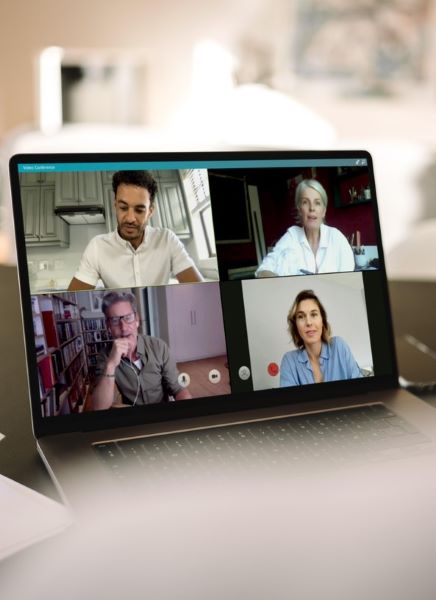Once a perk, flexible work arrangement has now become the norm. A recent study from the U.S. Bureau of Labor Statistics highlights that 19.5% of workers were teleworking as of August 2023, and predictions suggest this number will rise. By 2025, an estimated 32.6 million Americans will be working remotely.
While this location-based freedom is a welcome change for many, it can also be challenging to navigate as a manager. At KGO, we have found that managing remote teams is both an art and a science, involving a blend of autonomy, strategy, and quite honestly humanity.
In this blog, we explore the benefits of remote work, and provide actionable considerations you can start today to improve your remote or hybrid team’s overall experience.

The Benefits of Remote Work
Before we dive into the “HOW,” let’s quickly focus on the “WHY”. Many companies have found numerous benefits to allowing flexible work arrangements. So, why remote work?
- It is ecofriendly. Remote work significantly reduces the need for daily commuting, which has a direct positive impact on the environment. With fewer cars on the road, there is a notable decrease in greenhouse gas emissions, air pollution, and traffic congestion. contributing to cleaner, healthier communities.
- The talent pool expands. Embracing remote work allows companies to tap into a global talent pool, breaking geographical barriers that traditionally limit recruitment. By expanding the search for talent beyond local or regional boundaries, businesses can hire diverse minds from anywhere in the world. This diversity in talent not only fosters innovation and creativity but also ensures that companies are equipped with a wide range of skills and perspectives, enhancing their competitive edge in the market.
- It helps the bottom line. By reducing the need for large office spaces, companies can save on rent, utilities, and maintenance costs associated with maintaining physical offices. Additionally, expenses related to office supplies, furniture, and amenities like coffee and snacks are minimized. These savings can be redirected towards other critical areas such as employee development, technology upgrades, or business expansion.
- Work-life balance can be actually achieved. One of the most significant benefits of remote work is the increased flexibility it offers employees. The ability to work from home or any location of their choice allows employees to better balance their work and personal lives. This flexibility can lead to improved job satisfaction, reduced stress, and overall happier employees. When employees are content and feel trusted by their employers, it often results in increased loyalty and lower turnover rates.
- Employees can customize their experience. Remote work can enhance productivity for many employees. Without the constant oversight and interruptions that often occur in a traditional office setting, employees can focus more on their tasks. The autonomy and control over their work environment allow them to create a setup that maximizes their efficiency and comfort. Moreover, remote work eliminates the time and energy spent on commuting, allowing employees to start their workday earlier or use that time for personal well-being.
All great benefits, but there are two sides to every story… as we all know.

Recently, KGO invited Laughter On Call to host a virtual event for our team, “Happier Hour: Team Building & Connection.” It was a session filled with laughter and togetherness, reminding us that it’s important to find reasons to laugh, especially when the days can feel like they are filled with never-ending Teams calls.
The Challenges of Managing a Remote Team
The challenges that remote teams face are not new developments. However, these challenges can look and feel different, which makes them harder to anticipate, identify, and solve. It’s ok to acknowledge they exist though; we can’t emphasize this enough. There is a light at the end of the tunnel.
So, let’s take a look at what could be causing problems for you and your team.
- It is absolutely more complicated. Managing remote teams involves extra layers of complexity, such as coordinating across different time zones and cultural norms. This requires consistent team tools and practices to keep everyone aligned and to minimize disruptions.
- It can be harder to develop trust (virtually). Building relationships is harder than in person due to the lack of spontaneous interactions. Team members need to be intentional about creating opportunities for social interaction to foster a cohesive team
- Burnout is harder to recognize. Working in a remote or hybrid team can sometimes lead to employees feeling overwhelmed and overburdened. Burnout is a response to extended, excessive stress and can occur when employees feel under-challenged or unfairly treated. Stress produces urgency and hyperactivity, while burnout can be seen as disengagement or hopelessness.
- There are many communication barriers. Remote teams face communication challenges due to the lack of non-verbal cues, language proficiency differences, time zones, and technical issues. These barriers can lead to misunderstandings and require proactive measures to ensure effective communication.
- Technology glitches are a struggle. Remote teams depend heavily on technology for collaboration, which can be problematic during technical difficulties. Ensuring team members are proficient with digital tools and providing support for technical issues is crucial.
- Proximity bias is a real thing. This term means favoring team members who are physically closer, giving them more opportunities and resources than remote workers. Remote work can lead to some team members feeling less visible, resulting in unequal recognition and career advancement opportunities. Leaders need to actively prevent this bias to ensure all team members are equally valued.
Strategies for Managing a Remote Team
If you are a manager of a remote or hybrid team, we see you. It is tricky but also within reach to adjust. You have control to improve and sustain your team productivity, collaboration, connections and ultimately, trust. The best part is once these exist, your people will more easily face and overcome whatever comes their way together.
So, how do you develop trust? There is not a magic formula unfortunately, but the goal is for every member of your team to feel safe – psychologically safe that is. Which means, that team members can speak up, share ideas, ask questions, and admit mistakes without fear of negative consequences. Everyone needs to feel respected and valued.
Consider these tactics and mindsets to begin improving your remote team experience.
- Schedule regular team-wide virtual meetings. Yes, people are going to decline or provide excuses to not regularly attend these touchpoints, but don’t let that stop you from a standing meeting that people can depend on. This should include opportunities for all interested to share and provide feedback openly.
- Proactively identify burnout. Establish “check-ins” as part of your normal team behavior. Consider reducing meetings or redistributing workloads – if this is possible. Exhaust your options, even temporarily, to encourage employee well-being.
- Document discussions and decisions. Capture and build on the progress you make as a team! Ensure everyone knows where to access to information and ask questions about any decisions.
- Set clear criteria for work activities. Clarity, clarity, and more clarity. A remote team needs to eat and breathe clarity. It’s oxygen for a team. What, when, how and why. Ensure all team members, regardless of where they work, have a clear understanding to focus their efforts and activities.
- Actively seeking input from all team members. Diverse thoughts and ideas strengthen. It’s a fact. Constantly strive towards finding opportunities for people to increase the trust and security they feel on your team, just by having the ability to speak and share. Please do not take this critical element for granted.
- Pay attention to your team communication practices. What is getting in the way? What is blocking individuals or groups from receiving information and therefore likely causing issues. It is easier said than done sometimes to remove communication barriers, but a good first step is to identify and acknowledge they exist. Then create new communication norms together. Establish workflows for everyday communications such as answering questions, problem solving, and status updates.
- Promote growth mindsets by talking about mistakes as opportunities to gain experience. People are afraid to fail, so encourage failure. I know it sounds ridiculous but promote and reward “trying” and “learning” and “growing” vs just “winning.” There is a high chance this will lead to more wins anyway.
- Focus on strengths. Position employees to consistently leverage their skills and experience to advance the team goals. Encourage teammates to help and rely on one another. And even, ask for help. Make it the thing to do.
- Highlight the positive work people are doing. Employee recognition is a valuable tool. Call out actions, ideas, and behaviors that contribute to a team’s growth. This will bring the team that much closer together, and more able to produce and perform.
Finally, get to know one another. Be strategic about how your team can begin to see each other as human vs coworkers. Authentic relationships take time, and let’s share what we can just by asking and answering simple questions.
More Advice from the KGO Team



The remote work revolution has fundamentally changed the way we manage teams and projects. Embracing this shift requires not just adapting to new tools and methods, but also fostering an inclusive, supportive, and engaging work environment. By understanding the unique challenges of remote work, from communication barriers to preventing burnout, leaders can create a thriving remote team culture.
At KGO, we believe in empowering leaders with the knowledge and strategies needed to navigate this new landscape. From establishing psychological safety to recognizing and addressing proximity bias, our insights aim to make remote work a successful and rewarding experience for everyone involved.
If you need assistance in educating your team leaders, KGO can help. We have successfully supported the nation’s largest energy delivery company and can bring the same expertise to your organization. Embrace the future of work with confidence and let KGO guide your journey towards exceptional remote team management.